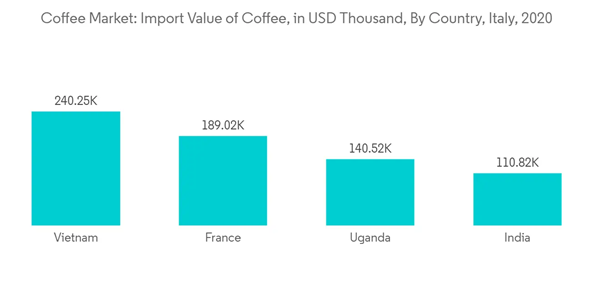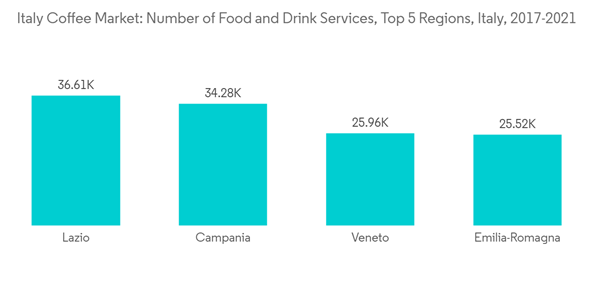The Italian coffee market is projected to register a CAGR of 3.35% over the next five years.
In Italy, the increased personalization within the coffee industry, from coffee beans to standard ground coffee and coffee pods, and the availability of different ranges of products offering high-quality coffee pods and capsules are expected to support the market growth. As in-home consumption represents a significant share of the coffee market, the segment is becoming increasingly diverse at a steady pace, with a wide range of options available in terms of quality (standard and specialty coffee), origins, blends, and product forms (whole beans, ground, capsules, pods, coffee extracts, and instant coffee).
Italians have a robust coffee-drinking culture and prefer to drink coffee from local independent coffee shops. Increased personalization within coffee in Italy, from coffee beans to standard ground coffee and coffee pods, along with the availability of different products offering high-quality coffee pods and capsules, is expected to support the market growth. Global players have undertaken comprehensive marketing campaigns to position the new developments in the Italian market. Many 16 to 34-year-old Italian coffee drinkers are interested in trying cold-brew coffee, and the slow-brewed concept is likely to appeal to the market.
According to the United Nations Comtrade database on international trade, Italy imported coffee, tea, mate, and spices worth USD 1.95 billion in 2021. The availability of a wide range of coffee types, flavors, and brewing styles and growth in the number of food outlets and retail stores are the drivers fuelling the development of the coffee market. According to the BEVERFOOD Edizioni Srl, between 2017-2021, Americano, Cappuccino, and Espresso were the most popular coffee varieties in the country.
There is a relative lack of knowledge about what constitutes quality. With growth primarily expected from traditional brands of local specialty shops and Starbucks, the imminent arrival into the market helps the growth of the coffee market during the forecast period. The incoming of Starbucks in Italy is expected to increase the availability of different coffee products in the market studied.
This product will be delivered within 2 business days.
In Italy, the increased personalization within the coffee industry, from coffee beans to standard ground coffee and coffee pods, and the availability of different ranges of products offering high-quality coffee pods and capsules are expected to support the market growth. As in-home consumption represents a significant share of the coffee market, the segment is becoming increasingly diverse at a steady pace, with a wide range of options available in terms of quality (standard and specialty coffee), origins, blends, and product forms (whole beans, ground, capsules, pods, coffee extracts, and instant coffee).
Italians have a robust coffee-drinking culture and prefer to drink coffee from local independent coffee shops. Increased personalization within coffee in Italy, from coffee beans to standard ground coffee and coffee pods, along with the availability of different products offering high-quality coffee pods and capsules, is expected to support the market growth. Global players have undertaken comprehensive marketing campaigns to position the new developments in the Italian market. Many 16 to 34-year-old Italian coffee drinkers are interested in trying cold-brew coffee, and the slow-brewed concept is likely to appeal to the market.
Italy Coffee Market Trends
Lifestyle and Culture Drives Coffee Market in Italy
Coffee is an integral part of Italian culture. Italians value high-quality coffees and are loyal to specific flavors and Italian brands. Coffee is consumed at various moments of the day, usually with sugar and no milk, except cappuccino, macchiato, marocchino, and caffè latte. In recent years, there’s been a sharp rise in single-person households. Also, young Italian professionals have a higher disposable income than in the past. Due to pessimism about the future, they’re keen to spend it because saving is seen as a pointless pursuit. They are particularly eager to spend on high-quality products and luxury brands.According to the United Nations Comtrade database on international trade, Italy imported coffee, tea, mate, and spices worth USD 1.95 billion in 2021. The availability of a wide range of coffee types, flavors, and brewing styles and growth in the number of food outlets and retail stores are the drivers fuelling the development of the coffee market. According to the BEVERFOOD Edizioni Srl, between 2017-2021, Americano, Cappuccino, and Espresso were the most popular coffee varieties in the country.
Increasing Out-of-Home Coffee Consumption Boosting the Market
With the strong heritage of traditional coffee-drinking culture, Italians prefer to drink coffee from local independent coffee shops. Italy is the leading country in the number of out-of-home coffee servings in Europe. With the growing consumer trends for convenience, healthier eating will disrupt the country's traditional coffee market. Coffee quality is considered a leading success factor for a coffee shop in Italy. According to Federazione Italiana Pubblici Esercizi, nearly 6.6 million people visited Italian restaurants in 2021, and the country's out-of-home food and beverage consumption including the coffee business generated sales of about USD 65.23 billion.There is a relative lack of knowledge about what constitutes quality. With growth primarily expected from traditional brands of local specialty shops and Starbucks, the imminent arrival into the market helps the growth of the coffee market during the forecast period. The incoming of Starbucks in Italy is expected to increase the availability of different coffee products in the market studied.
Italy Coffee Market Competitor Analysis
The market is highly competitive and fragmented, with several players operating, including Nestle SA, Kimbo SpA., and Luigi Lavazza S.p.A. The sustainable competitive advantage through differentiation is high. Manufacturers are increasingly introducing product innovations in terms of offerings, price, and packaging, leading to a high degree of competition in the market. Due to the high growth potential of coffee in European countries, most companies are trying to establish themselves in these regions by expanding their production lines to serve the increasing need for coffee across the region. Advanced marketing strategies used by the key players and the wide variety of flavors have contributed to their growing popularity in Italy and other European countries.Additional benefits of purchasing the report:
- The market estimate (ME) sheet in Excel format
- 3 months of analyst support
This product will be delivered within 2 business days.
Table of Contents
1 INTRODUCTION
4 MARKET DYNAMICS
5 MARKET SEGMENTATION
6 COMPETITIVE LANDSCAPE
Companies Mentioned (Partial List)
A selection of companies mentioned in this report includes, but is not limited to:
- Luigi Lavazza S.p.A.
- Nestlé S.A.
- Kimbo S.p.A.
- Massimo Zanetti Industries S.A.
- Gruppo Illy SpA (Illycaffè S.p.A.)
- Maxingvest AG (Tchibo GmbH)
- Italmobiliare S.p.A. (Caffè Borbone)
- Caffè Trombetta S.p.A.
- Gruppo Gimoka S.p.a.
- Casa del Caffe' Vergnano S.p.A
- Starbucks Corporation
Methodology

LOADING...










